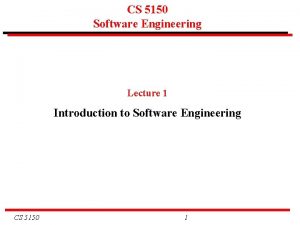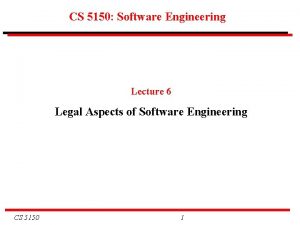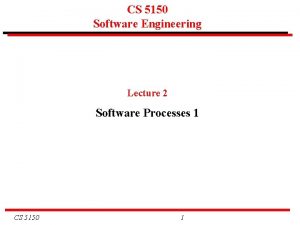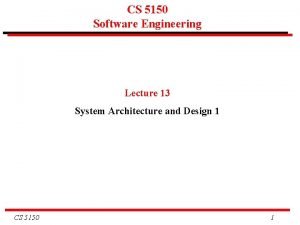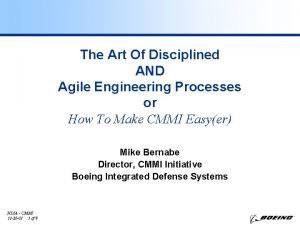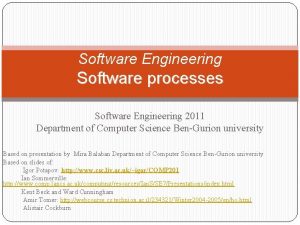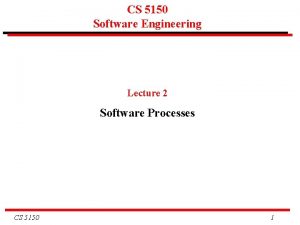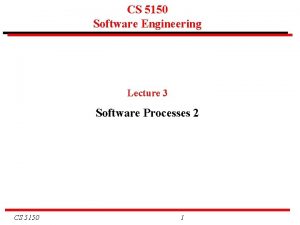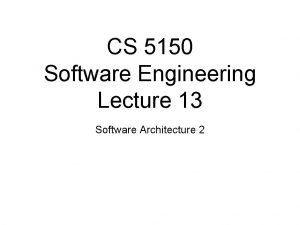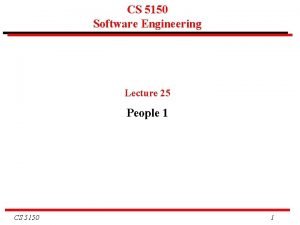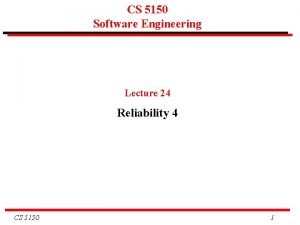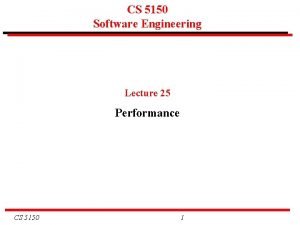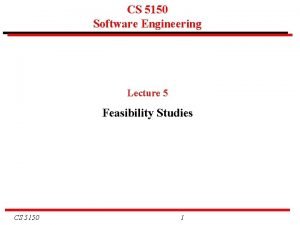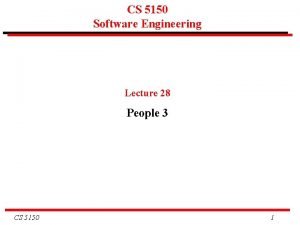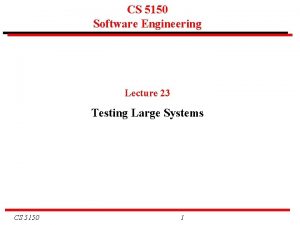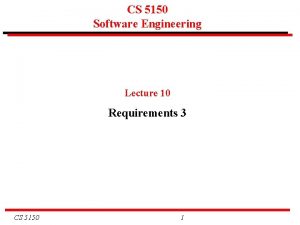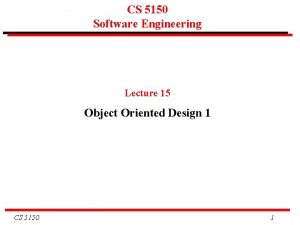CS 5150 Software Engineering Lecture 4 Software Processes






















- Slides: 22

CS 5150 Software Engineering Lecture 4 Software Processes 3 CS 5150 1

Administration Projects Announcements by project groups • Roll call of projects and team numbers • Who does not have a project team? CS 5150 2

Administration Project teams: • If you do not have a team, please meet after class. • If you are still having difficulty finding a team send email to the course team • We may ask teams to add extra members • If you have definitely chosen a project and reached agreement with your client, send email to the course team with the names of your team members CS 5150 3

Administration Test 1 See the Tests page on the web site. Monday, September 12 at 7: 30 p. m. in Phillips Hall 101. Two questions on material that has been covered in the lectures, including the class on the day of the test. Open book. You may bring any books or notes. Laptops can be used to store copies of the course materials and notes, but for no activity that involves networking. If you miss a test, there is no opportunity to retake it. CS 5150 4

Sequential Development: The Waterfall Model Requirements Feasibility study Requirements Design System design Implementation Program design Implementation (coding) Testing Acceptance & release Operation & maintenance CS 5150 5

Iterative Refinement Evaluation Requirements Design Implementation CS 5150 6

Incremental Development (Sprints) • For each increment (sprint) a team works through a full software development cycle including planning, requirements analysis, design, coding, unit testing, and acceptance testing. • Each sprint is completed in a fixed time period, e. g. , four weeks. • The size of an sprint is based on team size, e. g. , 5 -10 people. Sprint 1 Sprint 2 Accept Sprint 1 CS 5150 Sprint 3 Accept Sprint 2 7 Accept Sprint 3

Discussion of the Waterfall Model Advantages: • • Process visibility Separation of tasks Quality control at each step Cost monitoring at each step Disadvantages: Each stage in the process reveals new understanding of the previous stages, which often requires the earlier stages to be revised. The Waterfall Model is not enough! CS 5150 8

Sequence of Processes A pure sequential model is impossible Examples: • A feasibility study cannot create a proposed budget and schedule without a preliminary study of the requirements and a tentative design. • Detailed design and implementation reveal gaps in the requirements specification. • Requirements and available technology change with time. The plan must allow for some form of iteration. CS 5150 9

Modified Waterfall Model Feasibility study Waterfall model with feedback Requirements This is better System design Program design Implementation (coding) Testing Acceptance & release Operation & maintenance CS 5150 10

Discussion of Iterative Refinement Concept: Initial implementation for client and user evaluation, but not for release, followed by refinement until system is complete. • User interface mock-up • Throw-away software components • Dummy modules • Rapid prototyping • Successive refinement CS 5150 11

Iterative Processes: Requirements and Risk Mistakes in the requirements are the most expensive to correct. Requirements are hard to understand until there is an operational system, particularly with user interfaces Create an outline system quickly, review it with clients, test it with users, improve the understanding of the requirements Example: Start-up time of launching a complex application. CS 5150 12

Incremental Development (Sprints): Discussion A simple system with basic functionality is brought quickly into production. Subsequent sprints are based on experience gained from users of each previous release. Advantages • Pay-back on investment begins soon. • Requirement are more clearly understood in developing subsequent sprints – minimize waste. • User feedback can be incorporated in later phases. Challenge A high-level team must establish overall architecture and coordinate increments CS 5150 13

Incremental Development of Online Systems When software is released online it is possible to divide it into small increments that are developed and released in quick succession. This approach is excellent for continual enhancement of a system within an established architecture. It is not possible for shrink wrapped software, embedded systems, or similar environments. CS 5150 14

Mixed Processes In practice, many large projects create a process that is suitable for the specific development. For example: • A system may use a sequential process with iteration within the individual process steps. This is sometimes called a spiral development process. • User interfaces have to be tested with users. This forces iterative development, even within an underlying sequential process. • A phase 1 system may be developed by iteration and used as requirements for a phase 2, which is developed sequentially. CS 5150 15

Examples of Mixed Processes: Iterative Refinement + Waterfall Model: Problem: Add graphics package to a programming environment Phase 1: Iterative refinement Extend current environment with a preprocessor and run-time support package. Test with users. Make several new versions until users are pleased with function. Throw the code away. Phase 2: Modified waterfall Use the results of Phase 1 as the basis for a formal set of requirements. Write new compiler and run-time system incorporating graphics elements. Make minor adjustments to requirements as needed. CS 5150 16

Corporate Processes Large software development organizations have their own internal processes that are designed for their needs. For example: • Amazon. com (Internet commerce) divides most software development into phases of about four weeks elapsed time. • Lockheed Martin (government contactor) follows a process that fits with the way that the US government manages software contracts. • SAP (business software) emphasizes the functionality that is seen by their business customers. • Microsoft (PC software) places great emphasis on testing with a very wide variety of equipment and backward compatibility. CS 5150 17

Modern Developments in Software Processes Changes during the software development process are expensive. • If the requirements are poorly understood, or expected to change, select a process that keeps flexibility. Iterative refinement, sprints, phased implementation. • For big software systems with many inter-related components, avoid major changes to the design of a system during development. Sequential process, such as the modified waterfall model. • If the market for the software is poorly understood, use an incremental process that gets operational software in front of customers as quickly as possible. CS 5150 18

Observations about Software Processes Completed projects should have the basic process steps but. . . the development process is always partly evolutionary. Risk is lowered by: • Prototyping key components • Frequent releases, dividing large projects into phases • Early and repeated testing with users and customers. • Following a visible software process • Making use of reusable components CS 5150 19

CS 5150 Project Presentations: Iterative Option Evaluation Requirements first presentation second presentation third presentation Implementation CS 5150 Design 20

CS 5150 Project Presentations: Sequential Option 1. Requirements Feasibility study Requirements 2. Design System design Program design 3. Implementation (coding) If you follow a sequential process the three presentations should be as shown. CS 5150 Testing Acceptance & release Operation & maintenance 21

CS 5150 Project Presentations: Incremental Development Sprint 1 First release first presentation CS 5150 Sprint 2 Sprint 3 Second release Third release second presentation 22 third presentation
 Cs 5150 cornell
Cs 5150 cornell Cs 5150
Cs 5150 Cs 5150
Cs 5150 Cs 5150
Cs 5150 Cs 5150
Cs 5150 Requirement analysis in software engineering notes
Requirement analysis in software engineering notes Concurrent in os
Concurrent in os 01:640:244 lecture notes - lecture 15: plat, idah, farad
01:640:244 lecture notes - lecture 15: plat, idah, farad System procurement process in software engineering
System procurement process in software engineering Forward engineering in software engineering
Forward engineering in software engineering Manufacturing process for engineering materials
Manufacturing process for engineering materials Agile engineering processes
Agile engineering processes Financial engineering notes
Financial engineering notes Foundation engineering lecture notes
Foundation engineering lecture notes Descriptive ethics
Descriptive ethics Software maintenance process models ppt
Software maintenance process models ppt What is software implementation in software engineering
What is software implementation in software engineering Metrics computer science
Metrics computer science Types of software crisis
Types of software crisis Software measurement and metrics
Software measurement and metrics Real time software design in software engineering
Real time software design in software engineering Design principles in software engineering
Design principles in software engineering Software requirement and design
Software requirement and design
